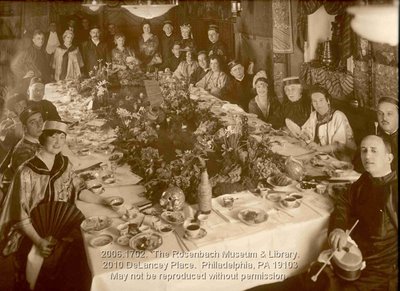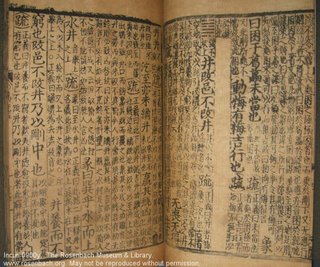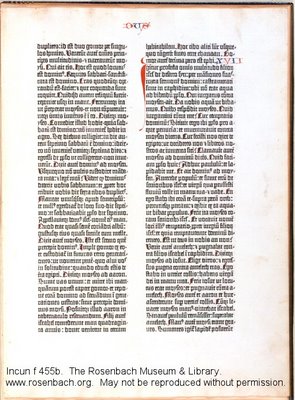 Sure Juan de Zumárraga’s Doctrina breue is the oldest surviving complete book printed in the Americas (see “Bay Psalm Book…” below). But let’s not forget that printing goes back a lot further than that. The world’s oldest known printed book, a copy of the Diamond Sutra, bears the date 868 C.E. So the Chinese were printing books — on paper, which they had also invented — way back in the in the 9th century while in Europe tonsured monks were sitting in dimly candlelit, drafty scriptoria getting hand cramps scratching out manuscripts with plucked, sharpened goose feathers on the soaked, dried, scraped, stretched, polished skin of some poor calf, goat or sheep, taking who knows how long to finish a single page, let alone a whole book, and would be for almost 600 more years. Look at this stuff. Yeah, it has pretty pictures and all, but seriously: can you even read it? (You can see a lot more of it here; a lot more detail on how they made these things is available here.)
Sure Juan de Zumárraga’s Doctrina breue is the oldest surviving complete book printed in the Americas (see “Bay Psalm Book…” below). But let’s not forget that printing goes back a lot further than that. The world’s oldest known printed book, a copy of the Diamond Sutra, bears the date 868 C.E. So the Chinese were printing books — on paper, which they had also invented — way back in the in the 9th century while in Europe tonsured monks were sitting in dimly candlelit, drafty scriptoria getting hand cramps scratching out manuscripts with plucked, sharpened goose feathers on the soaked, dried, scraped, stretched, polished skin of some poor calf, goat or sheep, taking who knows how long to finish a single page, let alone a whole book, and would be for almost 600 more years. Look at this stuff. Yeah, it has pretty pictures and all, but seriously: can you even read it? (You can see a lot more of it here; a lot more detail on how they made these things is available here.)
Is there any major technological advance the Chinese didn’t lead the way on? Gunpowder, firecrackers, the compass, paper, printing; and that’s just the stuff an ignorant chump like me has heard about. Well, I say respect to the inestimable Chinese. I wonder if Philip Rosenbach (in the back, with the dashing moustache) was honoring the Chinese and their technologocial achievements when he hosted this dinner:
Whatever Philip and friends were up to that night, the Rosenbach brothers did recognize and respect what Chinese printers had accomplished. They made sure their collection had a sample of Chinese printing, a book that was produced long before Gutenberg printed his first Bible in 1455*. The book in question is 10th-century copy of the I-Ching, printed during the Sung Dynasty.
Now, if you’re looking closely, you might suspect that this book wasn’t printed using the letter press technique Gutenberg perfected. And you’d be right. Chinese printing at this period was block printing — the text of the whole page was carved on a block and then printed. It wasn’t typesetting — composing words and pages from individual characters, as in movable type printing. In the 11th-century Chinese printers did invent movable type, but they apparently didn’t like it — the Chinese writing system had way too many characters to keep track of to make movable type really useful. One other detail about Chinese printing: apparently they didn’t have the technology to print on two sides of a page (Gutenberg figured out that piece.) If this book is typical of others from the period, they devised a clever solution to that problem. First a large page was printed from the block. The page was then folded down the middle, from top to bottom. That folded edge then became the fore-edge of the page and the open ends were sown together in the binding. As a result, the pages look like they’ve been left unopened. But if you were to cut open that fold along the fore-edge, the inside pages would be blank, of course, because there’s nothing printed there. Hopefully this photograph helps make the description above a bit more intelligible:

(You’ll notice paper inside the printed pages. It’s opaque while the paper with the printing is not — I assume it’s there to prevent the printing from showing through from one page to the other which would make the page more difficult to read.)*Of course the Rosenbachs had a sample of Gutenberg’s handiwork, too:
 Doctor Rosenbach handled a great many Gutenberg Bibles, but he only kept this one token, a page from Exodus (chapters 16-18), for himself. Perhaps Gutenberg’s Bibles weren’t rare enough for his library? Images (starting from top of post):
Doctor Rosenbach handled a great many Gutenberg Bibles, but he only kept this one token, a page from Exodus (chapters 16-18), for himself. Perhaps Gutenberg’s Bibles weren’t rare enough for his library? Images (starting from top of post):
1. Edward A. Wilson, “Success at last!”, from Douglas C. McMurtrie, Wings for Words: The Story of Johann Gutenberg and His Invention of Printing.
New York: Rand McNally and Co., 1940
2. [Chinese-themed dinner hosted by Philip H. Rosenbach][Philadelphia?: unknown date]2006.1702
3 and 4. Yi-King [The Book of Changes][China, Sung Dynasty: 10th-century, C.E.]Incun 0900y
5. Biblia Latina
[Mainz: Johann Gutenburg, 1455]Incun f. 455b
Images in links:
1. John Lydgate
[Philadelphia?: unknown date]MS f. 439/16 2. Horae
[Tours, France?: ca. 1510]MS 1057/293. Biblia Latina
[Mainz: Johann Gutenburg, 1455] Incun f. 455b
